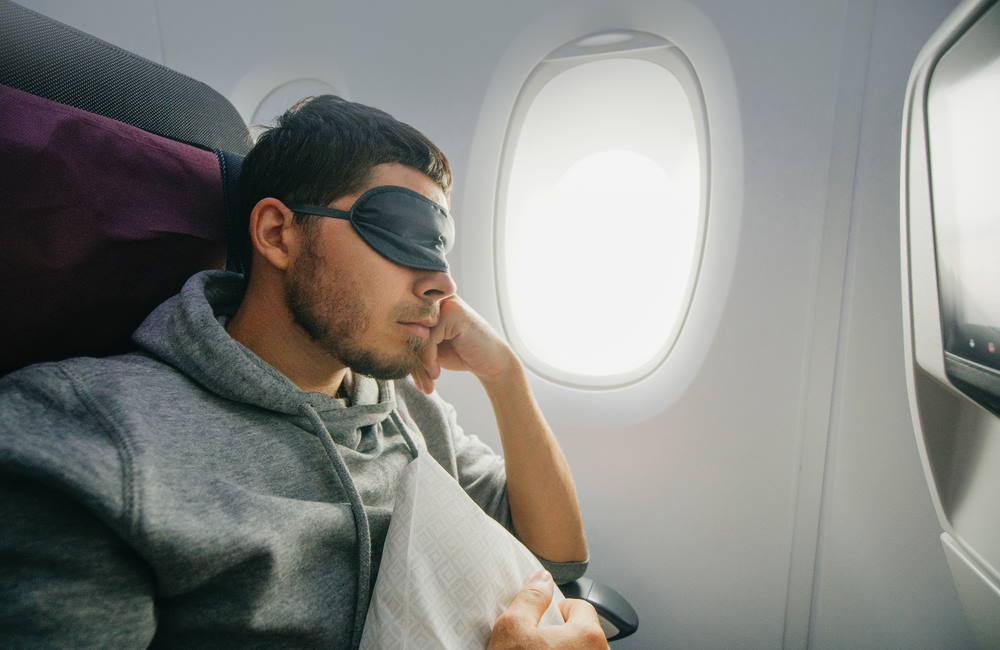
Unless you’re seated in first class, sleeping on a plane is a tough task to accomplish. And even those in the best seats might still find it hard to tune out the plane noise and conversations going on around them, as well as find a comfortable position. It’s a problem.
Fortunately, it’s a problem with solutions. Years of trial and error have helped people develop travel hacks, including ways to get good sleep.
Even for those who still plan to wear masks during long flights, it’s possible to catch a little airborne sleep time. As Bob Bacheler, managing director of Flying Angels, told the Washington Post about sleeping on overnight flights, it’s “nearly impossible” to sleep well with an N95 mask, because the masks aren’t designed for comfort or to work on long flights. He told the Post: “The key to sleeping with a mask is to find one that’s comfortable to wear.”
Why Is Sleeping On a Plane So Hard?
For people with anxiety about flying on an airplane, it’s easy to understand why they might have difficulty dropping off while in the air. But most people eventually relax, especially on an overnight flight or other long flight. But relaxing on a plane is one thing. Sleeping on a plane is another. Plenty of roadblocks stand between you and getting good sleep while in the air, especially on overnight flights.
Sitting up. The human body is incredible, but there’s one thing it’s not made to do: sleep while sitting straight up. Especially when you’re sitting straight up in a narrow plane seat right next to someone you may not even know.
REM sleep. About 70 minutes or so into sleep, your body moves into REM sleep, a deep sleep state. One of the features of this state is that the body shuts down voluntary muscles. That means your head might flop over onto your seatmate or you might slide against the window – movements that jolt you awake.
Fluctuating temperatures. Swings in temperature can wake you up under the best of circumstances. On a plane, those swings can be dramatic and happen often.
Noise. Jet engines make plenty of noise, of course. There’s also the sales guy chatting up the whole row behind you and the baby crying across the aisle. Planes have dozens of noises that can jar you back to consciousness.
Tips for Sleeping on a Plane
Even with the above obstacles, there are ways to get sleep on an overnight flight. They range from what you wear to technology that can help. All of them can give you a better chance to get good sleep while flying.
Dress in layers. Handle those temperature changes by bringing a light jacket or hoodie that you can easily slip into or out of, depending on the temperature. They also make for great temporary pillows.
Light-blocking mask. Someone always decides it’s time to read, even on an overnight flight, and flips on their overhead light. Cabin lights may also come on. Protect yourself from those sleep-killing factors by wearing a light-blocking mask over your eyes.
Watch what you eat. High altitudes cause gas to expand, which can lead to a lot of discomfort in the stomach. Stay mindful about what you eat before a flight, sticking with items such as bananas, fruit smoothies, fresh bread, and crackers.
Try pink noise. White noise broadcasts all frequencies that humans can hear, but all equal in strength. Pink noise decreases the volume of higher frequencies. It’s a sound experience that resembles listening to rain or sea waves and is great at promoting restful sleep.
Add a pillow. Use a support pillow for your lower back, which can help reduce the risk of experiencing pain. Also, putting your elbows on the seat rest can alleviate pressure on your back.
Stay hydrated. The air in plane cabins, which typically has only about 20 percent humidity, can make it difficult to sleep by drying out your nasal passages and throat. Drink plenty of water (about 8 ounces for every hour you’re in the air) and use nose drops to add moisture.
These tips can help lead to better sleep on a plane, which means you will enjoy yourself much more when you land, rather than rushing to find a place to lie down and make up for lost sleep.
